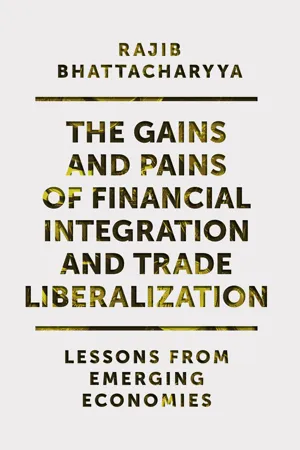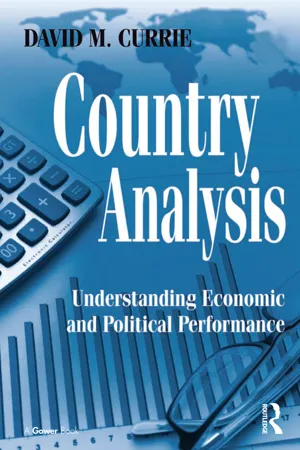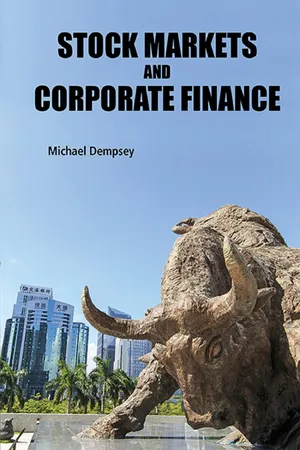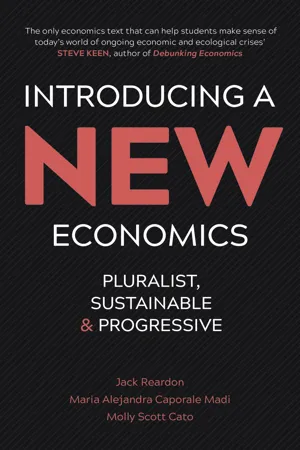Economics
Exchange Rate and Inflation
Exchange rate and inflation are interconnected in the economy. When a country's currency depreciates, imports become more expensive, leading to higher inflation. Conversely, a stronger currency can lower inflation by making imports cheaper. Exchange rate movements can impact inflation through their effects on the prices of imported goods and services, influencing a country's overall price level.
Written by Perlego with AI-assistance
Related key terms
7 Key excerpts on "Exchange Rate and Inflation"
- eBook - ePub
The Gains and Pains of Financial Integration and Trade Liberalization
Lessons from Emerging Economies
- Rajib Bhattacharyya(Author)
- 2019(Publication Date)
- Emerald Publishing Limited(Publisher)
2016) for details). This is particularly true post 2008–2009, where we can decipher that high values of exchange rate are congruent with high inflation rate and low growth rate of GDP. Especially, post 2009–2010, while exchange rate started heading northward, GDP growth rate marched southward. On the other hand, both CPI inflation and exchange rate went hand in hand, on an upward trajectory (on an average).Fig. 14.1.Indian Growth, Inflation, and Exchange Rate.Source: RBI, Author's Calculations.Investment, trade, and capital flow channels are the routes through which India's growth rate is affected. Let us explain. First, India's major driver of growth has been investment, which is highly dependent on import of oil, capital, and intermediate good, and thus, exchange rate. A rise in exchange rate (fall in R/$ rate) raises profitability of investment by reducing the cost of import as well as raises the net worth of firms and reduces the latter's external finance premium. Further debt of firms (serviceable in terms of domestic goods) also affects investment adversely. A rise in exchange rate increases value of debt in terms of domestic currency (and also in real terms), adversely affecting investment. Thus, low exchange rate is a beneficial factor for high growth. Secondly, India's exports are highly import-intensive (like import of oil, gems, raw materials, chemicals, capital goods, etc.). Therefore, a rise in exchange rate does not lead to much improvement in the net export of the country. Let us elaborate. A rise in exchange rate makes imports costlier. Since a rise in cost of imports feeds into the price of exports by raising it, it raises costs of imports for foreign countries, thereby not leading to a sufficient rise in exports. Finally, a rise in exchange rate feeds into the domestic price level (though imperfectly) and reduces real value of money holding or wealth, reducing consumption (through real balance effect) and hence, aggregate demand. From Fig. 14.1 - eBook - ePub
Country Analysis
Understanding Economic and Political Performance
- David M. Currie(Author)
- 2016(Publication Date)
- Routledge(Publisher)
Because we’ve discussed these forces already, we won’t spend much time on them here. However, two forces have particular influence on exchange rates over time: the relative rates of inflation between two countries and relative interest rates between two countries.PURCHASING POWER
An economic principle known as the law of one price argues that the exchange rate ought to reflect the relative purchasing power between two countries. If the exchange rate doesn’t reflect underlying prices, it will be possible to earn profits by purchasing a product in one country and selling it in the other. Here is the reasoning.Suppose a tube of toothpaste sells in Europe for 1 EUR. Using the spot rate in equation (1), the identical toothpaste ought to sell in the US for 1.3890 USD per tube. If it didn’t, people would purchase toothpaste in one location and sell it in the other. For example, if the tube sold for 1 EUR in Europe but only 1.10 USD in the US, Europeans would purchase the toothpaste in the US for the equivalent of .7919 EUR (1.10 USD/1.3890 USD/EUR = .7919 EUR), ship it to Europe, and sell it for a profit of .2081 EUR per tube (1.00 EUR sales price – .7919 EUR cost = .2081 EUR profit). Americans would take their toothpaste to Europe and sell it for 1 EUR, exchange the 1 EUR for 1.3890 USD (1 EUR * 1.3890 USD/EUR = 1.3890 USD), and realize a profit of .2890 USD (1.3890 USD sales price – 1.1000 USD cost = 0.2890 USD profit).The profit potential won’t persist because so many people will buy dollars so they can buy toothpaste in the US that the dollar will appreciate against the euro. The situation will stabilize only when the exchange rate reflects the purchasing power of the currencies of each country. This is an example of a concept known as arbitrage - eBook - ePub
- Michael Dempsey(Author)
- 2017(Publication Date)
- WSPC (EUROPE)(Publisher)
Chapter 2 , we observed how in the 1980s, the rise of the dollar became self-sustaining as it rose because the markets expected it to rise, before, as the situation began to be questioned with the realization that America might ultimately have to pay for its imports by trading its own goods and that the required mechanism would have to be a lower dollar, speculative forces acted in the opposite direction as investors moved away from their dollar assets. At which point, the dollar’s fall became as self-sustaining as much of its earlier rise had been.(5) The currency’s inflation and interest rates.The impact of inflation on prices should be that a currency depreciates in value against the currencies of those economies that have a relatively lower inflation in prices. We can see this intuitively as the principle that a decrease in the domestic purchasing power of a currency (which is what we mean by inflation) should transfer to a similar decrease in the currency’s purchasing power internationally. Consider, for example, that Australian imports and exports with Europe are in equilibrium at an exchange rate of 1 Euro = 1 Aussie dollar. Now, suppose, for some reason, that inflation in Australia is 100% over a period, while that in the Euro zone remains unchanged. With other goods and wages in Australia now generally twice as high as before the rise in inflation, European imports to Australia will appear to be only half as expensive as prior to inflation. But by the same token, Australians will wish to price their exports to Europe at twice the cost prior to inflation. The outcome is that Australians should now be prepared to pay twice as much in Aussie dollars for the Euro, while Europeans are not prepared to purchase Aussie dollars unless the price of the Aussie dollar drops by half. Thus, a 100% relative inflation in the Australian economy relative to zero European inflation has put pressure on a halving - eBook - ePub
Terms of Trade
Glossary of International Economics
- Alan V Deardorff(Author)
- 2014(Publication Date)
- WSPC(Publisher)
page 362 ).Real effective exchange rateThe effective exchange rate (page 126 ) adjusted for the rates of inflation (page 221 ) in each country.Real exchange rate1. The nominal exchange rate (page 308 ) adjusted for inflation. Unlike most other real (page 363 ) variables, this adjustment requires accounting for price levels in two currencies. The real exchange rate is: R = EP* /P where E is the nominal domestic-currency price of foreign currency, P is the domestic price level, and P* is the foreign price level.2. The real price of foreign goods; i.e., the quantity of domestic goods needed to purchase a unit of foreign goods. Equals the reciprocal of the terms of trade (page 429 ). Equivalent to definition 1.3. The relative price of traded goods (page 445 ) in terms of nontraded goods (page 312 ).Real GDPThe real counterpart to nominal GDP (page 308 ), obtained by valuing output in a given year at prices from another year, called the base year (page 28 ).Real interest rateThe nominal interest rate adjusted for inflation (page 221 ), to get the percentage yield an asset holder receives in terms of real resources. Equals the nominal interest rate minus the rate of inflation.Real modelAn economic model without money. Most general equilibrium (page 184 ) models of trade are real models. This includes the Ricardian model (page 378 ), the Heckscher-Ohlin Model (page 199 ), and the models of the new trade theory (page 306 ).Real money balancesThe real (page 363 ) value of the amount of money (page 287 ) held by a person, household, or firm, or the amount in circulation in the economy.Real national incomeNational income (page 297 ) adjusted for inflation (page 6 ).Real termsSame as real (page 363 - eBook - ePub
International Finance
Contemporary Issues
- Maurice D. Levi, Dilip Das(Authors)
- 2007(Publication Date)
- Routledge(Publisher)
This contrasts with the conclusion in Figure 6.7a where inflation in Britain alone causes the pound to depreciate by the rate of inflation. What is similar in the two equilibria is that the quantity of currency traded is the same. That is, whether it is just Britain with 25 percent inflation, or Britain plus the United States with 25 percent inflation, the quantity of pounds exchanged grows by 25 percent. 7 More generally, the above analysis can be extended to show that a country’s exchange rate depreciates by the extent that the country’s inflation exceeds that of other countries. Of course, this assumes all other factors affecting exchange rates are unchanged. We know from the description of the balance-of-payments account in Chapter 5 that there are many factors behind the supply and demand curves for a country’s currency in addition to terms of trade, inflation and the other factors which affect the value of merchandise imports and exports. Let us consider how these other factors influence exchange rates by examining how they shift the supply and demand curves for pounds in Figure 6.3. Service trade, income flows, and transfers Imports and exports of services such as tourism, banking, consulting, engineering, and so on, respond to exchange rates in the same way as imports and exports of merchandise. Therefore, the currency supply and demand curves derived from international trade in these services look like those in Figure 6.3. The currency supply curve from importing services can be added to that due to importing merchandise, and the currency demand curve from exporting services can be added to that from exporting merchandise. This has the effect of shifting both S £ and D £ in Figure 6.3 to the right. We can think of the currency supply and demand curves for imports and exports of services as being ‘‘horizontally added’’ to the currency supply and demand curves from imports and exports of merchandise - Imad A Moosa(Author)
- 2013(Publication Date)
- WSPC(Publisher)
This is an index that shows how the price of a (hypothetical) basket of goods and services (called the market basket) changes over time. Another point to bear in mind is that not all price rises are inflationary. For example, prices may rise because of the imposition of new taxes or rising tax rates. Yet another observation is that inflation refers to a “sustained” or long-term rise in the general price level, not a one-off increase resulting, say, from a temporary bad harvest or a one-off hike in the price of crude oil. Inflation is, therefore, a continuous rather than discrete process. 1 Some economists, however, do not share this view, describing one-off price hikes as “inflationary bursts”. 2 Inflation is a dynamic process — it is about rising prices over time, not about prices being high at a particular point in time. Prices could be high but the inflation rate could be zero; or, prices could be low but inflation could run at a high rate. Naturally, inflation leads over time to a high level of prices. As we are going to see, some economists believe that inflation is purely a monetary problem resulting solely from monetary growth, which is nothing but an increase in the money supply over time. While not all economists subscribe to this view, most economists believe that (at least in the long run) inflation, whatever its cause may be, must be validated by an increase in the money supply (otherwise it will be suppressed inflation). The extreme monetary view is that there is a proportional relation between growth in the money supply (monetary growth) and inflation. The idea is actually intuitive. An increase in the money supply makes money less valuable in terms of goods and services whose prices rise. Those who believe in this process tend to define inflation as a sustained increase in the money supply causing a sustained decline in its value- eBook - ePub
Introducing a New Economics
Pluralist, Sustainable and Progressive
- Jack Reardon, Maria Alejandra Caporale Madi, Molly Scott Cato(Authors)
- 2017(Publication Date)
- Pluto Press(Publisher)
If every nation in the world used the same currency, or, for that matter, if there was only one nation in the world – neither of which is very likely, or desirable – then the topic of exchange rates would be irrelevant. However, given that there are many nations and many currencies, and that these nations would like to trade with each other, the topic of exchange rates must be discussed.Let us define an exchange rate as: the price of one currency in terms of another.1 From this it is clear that this relationship is reciprocal, since one currency is always measured in relation to another, i.e. rather than say that the US dollar, for example, increased in value, we must say that the value of the dollar increased in relation to a specific currency, such as the European euro or the Japanese yen. And, since we measure one currency in terms of another, if one decreases in value, the other by definition increases.In July 2015, 1 British pound was worth US$1.56. This means that if you had visited the US with 1 pound in your pocket you could exchange it for US$1.56; and, given the reciprocal nature of the exchange rate, we know that 1 US dollar in July 2015 was worth 0.64 pounds: 1/1.56. One year later, in July 2016, 1 British pound was worth US$1.32. This means that the same tourist visiting the US with one pound could exchange it for US$1.32. And, conversely, 1 US dollar in July 2016 was worth 0.76 pounds. The pound in one year depreciated by 18 per cent: (1.56–1.32)/1.32 x 100 = 18 per cent. In other words, the same pound could buy fewer dollars; and, equivalently, the US dollar appreciated by 18 per cent, i.e. it could buy more pounds.If one currency is decreasing/increasing relative to another, what exactly does this mean? Think for a moment about the price of land. If the price of a hectare of land is increasing, this means you need more money to purchase it; or, alternatively, for a given sum of money you can buy less land. And conversely, if the price of land is decreasing, this means you need less money to purchase it; or, alternatively, a given sum of money will buy more land.
Learn about this page
Index pages curate the most relevant extracts from our library of academic textbooks. They’ve been created using an in-house natural language model (NLM), each adding context and meaning to key research topics.






